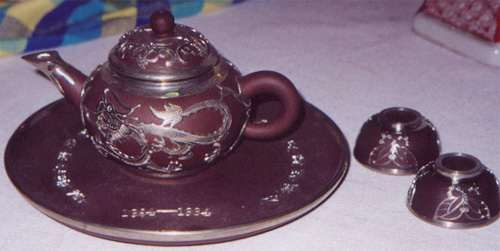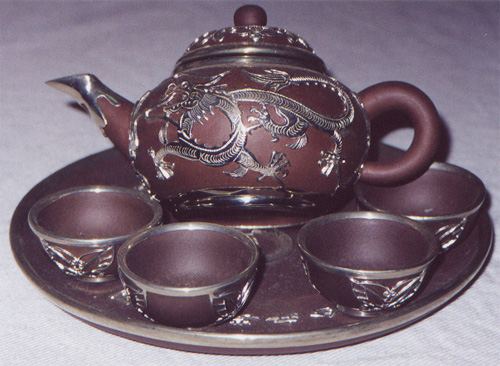We have prepared an authentication analysis on the following Yixing teaset.
Please study it together with us:

Firstly, it is difficult telling whether the piece is truly authentic as you
have to hold it to do so and take a close look at it.
From the photos (emphasising that the quality is not as good), it seems
authentic. This is due to the way the pewter is polished. You can still see
a tarnished appearance to it. This is usual for pewter. We know because our
region i.e. Malaysia and Singapore are the world's largest producers of
pewter goods.
However, the colouration and quality of the photo does not
allow us to see the actual colour and appearance of the set. I was told that it is manufactured in 1922.
So I am afraid that we have to take their word for it.
The style and design however can be found in the 1920s that is not within
doubt.
However, we have to emphasise that there are many imitations of such
wares. During the 1970s and 1980s, it is very popular for Chinese
restaurants to use such sets.
The reason why the Yixing teaset is embossed
with pewter is a tradition that was started in Qing dynasty. The Europeans
starting with the Dutch and later the English and Germans like to emboss
their wares with metals like pewter (cheaper) or silver (more expensive).
They are used due to two main reasons. Aesthetics and functionality.
Aesthetics because Europeans like metals and used metals in their cultery
etc. Functionality because metals are used to form hinges and latches on the
pottery. They slowly evolved to being main stays on the pieces themselves.

There are two main things that we cannot see from the photo. The
authenticity of the yixing clay as well as the EXACT age of the pewter. We
know that the pewter is not new and that is all. We also have to take the
word that it is in good condition. This is important because chipped yixing
pots lose more than half its value.
The photos do not show the bottom and
insides of the pieces and those are crucial for evaluation. The marks on the
bottom of the teapot seems authentic as I have seen such marks before (not shown in pictures).
They are well-spaced, well-impressed and the characters show i.e. the
brushstrokes of the characters are strong and skilful. It means that the
block that is used to impress the underneath is well made.
However, there
are good fakes as well. This is a point to note. Weihaiwei is a place in
Shandong province. It is in fact a place of somewhat historical importance
as it is the place where the Chinese had lost a war to the Japanese during
the Sino-Japan war. The whole reign mark means Made in the Sea of Weihaiwei.
This is rather suspicious as Weihaiwei is not well known for Yixing. In
fact, there is no Yixing clay in that area at all. thus, this is the first
point of contention. If this piece is made for a family in Weihaiwei, it is
understandable. But made In Weihaiwei is something strange. Shandong is
located in the north of China and it is not famous for its Yixing wares and
it does not have that clay. This is the first point of suspicion.
The carvings of the dragon is not as intricate as the top pieces. They are
medium level skills at most. however the finishing is good. this is rare in
those days as China was in great turmoil then and its good rarely had such
good finishings.
Overall evaluation, it is a good buy if:
you are NOT buying for investment
if you have money which you don't mind spending
if you like the design of the piece even if it turns out to be fake.
if you have spare cash and not buying this out of fanatical obsession.
if you would like to use it as a learning piece.
if you buy this piece and would like further evaluation please send more
photos to us, clear ones and taken from all angles and we can give you more
evaluation.
There is another point. If the
piece turns out to be real, it is worth more in asia than in US. In asia, if
it is a real piece, it can cost a range of a couple of hundred US dollars to
a couple of thousands depending on interest. Yixing teapots collection are a
rage now.



